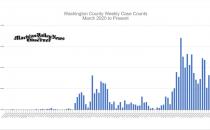Treasure hunt continues for Washington County meteorite; museum lab processing ‘loads’ of submissions
by Sarah Craighead Dedmon
Life in the Maine Mineral & Gem Society laboratory is much busier this week after throngs of treasure hunters have descended on Washington County, hoping to find a piece of the bolide meteor that streaked across the midday sky on Saturday, April 8.
Now those hunters are delivering their finds to the museum for analysis.
“We have loads of them,” said Dr. Al Falster, an experimental chemist and researcher at the Bethel museum, which houses the largest piece of Mars on Earth and has offered a $25,000 reward for a 1kg piece (roughly 2.2 pounds) of the meteor.
Falster recalled the specific rock found by friends Kelly Hinkle and James Hubisz of Columbia Falls, the first reported find from the meteor event, and said a high silica content was one indication it was not a meteor. The composition of rocks from Mars, Earth, and the moon have similarities, said Falster, but some key elements are missing or present in “overly large abundances.”
“You have to do a lot of these plots, as well as some mineral chemistry, because the rocks on our planet aren’t that much different,” said Falster.
This image was taken of a meteor from the recent meteor fall in Cranfield, Mississippi. NASA’s Dr. Marc Fries says a typical meteorite has a thin black crust. "It looks like a pottery glaze, and that’s because the heat from the fireball has melted the very surface," said Fries. "The interior is usually a light grey." Photo by Linda Fries
Hinkle and Hubisz’s rock was blackened on one side, and meteors often are blackened, but in this case, the cause of the discoloration revealed it was an earth rock, not a space rock.
“The outside was coated with a lot of iron and manganese oxide, but it was not a fusion crust,” said Falster, adding that meteorites feature rounded grains, not crystalline grains. “A fusion crust on a meteorite is glassy and non-crystalline.”
Along with “about 15 million other people” last weekend, Hinkle and Hubisz walked miles into the woods on their search. NASA”s map showing the likely “strewn field” of the meteor is fully within land managed by Wagner Land Management, which has closed the roads for mud season. Wagner has stated
Hinkle is the cameraman behind the popular Downeast Cowboy videos and a children’s book author. He posted this short video about their hunt this week. https://tinyurl.com/59zcrezm, and it has already been viewed more than 2 million times, which surprised him at first.
“People want to see things happen. They want people to find this, they want to be supportive,” said Hinkle. “To me, it was always the story, never the money. People love a good story, and regardless of the results, people followed along for the ride.”
Falster says that in addition to delivering specimens to the museum, people are emailing photos and calling with questions, and not all of them are about meteorites.
“They ask us questions like, why is the road blocked up there?” said Falster, who correctly deduced the gates are up because vehicles are not permitted during mud season.
NASA’s ARES lab confirms radar signatures that support meteor sightings across Washington County and New Brunswick, Canada, on Saturday, April 8. This map of the "strewn field" shows where the meteorites may have landed based on radar signatures, scaled from 10kg (red) to 1g (yellow). The region covered by this radar cone is managed by Wagner Forest Management, and all roads are currently shut to motorized traffic due to mud season. Photo courtesy NASA
Maine Game Warden Brad Richard anticipates vehicles will be able to enter the meteor’s strewn field by mid-May.
“Access is really a major, major issue right now,” said Richard. “Essentially, that entire road system from Route 6 all the way down to Indian Township is completely closed off and gated."










